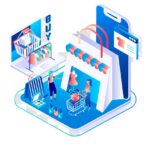Introduction
In today’s digital age, an online store is no longer a luxury but a necessity for businesses. But simply having a website isn’t enough; it needs to be well-designed, user-friendly, and optimized for conversions. This guide will walk you through the essential steps to designing an online store website that not only looks great but also drives sales.

Step 1: Define Your Brand and Target Audience
Before diving into design, you need a clear understanding of your brand and who you’re selling to.
- Brand Identity: What are your brand values? What’s your unique selling proposition (USP)? What kind of aesthetic do you want to project? Define your brand’s color palette, typography, and overall visual style.
- Target Audience: Who are your ideal customers? What are their needs, preferences, and pain points? Understanding your audience will help you tailor your website design to resonate with them.
Step 2: Choose an E-commerce Platform
Selecting the right e-commerce platform is crucial. Popular options include:
- Shopify: User-friendly, highly customizable, and great for beginners.
- WooCommerce (WordPress): Powerful and flexible, ideal for those familiar with WordPress.
- BigCommerce: Robust platform with advanced features for scaling businesses.
- Squarespace Commerce: Visually appealing and easy to use, suitable for smaller stores.
- Etsy: good for handmade and vintage items.
Consider factors like pricing, features, scalability, and ease of use when making your decision.
Step 3: Plan Your Website Structure and Navigation
A well-organized website is essential for a positive user experience.
- Sitemap: Create a sitemap outlining the main pages of your website (homepage, product pages, about us, contact, etc.).
- Navigation: Design a clear and intuitive navigation menu that allows users to easily find what they’re looking for. Use categories and subcategories to organize products.
- User Flow: Map out the customer journey from landing on your website to completing a purchase.
Step 4: Design Your Homepage
Your homepage is your digital storefront. It should make a strong first impression.
- Hero Section: Use a high-quality image or video to showcase your brand and key products.
- Product Highlights: Feature your best-selling or featured products.
- Call to Action (CTA): Encourage visitors to take action (e.g., “Shop Now,” “Learn More”).
- Social Proof: Include customer testimonials or reviews.
- Clear Value Proposition: Quickly communicate what makes your store unique.
Step 5: Create Compelling Product Pages
Product pages are where conversions happen.
- High-Quality Images: Use multiple images from different angles.
- Detailed Product Descriptions: Provide comprehensive information about product features, benefits, and specifications.
- Pricing and Shipping Information: Clearly display pricing and shipping details.
- Add to Cart Button: Make the “Add to Cart” button prominent and easy to find.
- Related Products: Suggest related products to encourage upselling and cross-selling.
Step 6: Optimize for Mobile Devices
With the majority of online shoppers using mobile devices, a mobile-responsive design is essential.
- Responsive Design: Ensure your website adapts seamlessly to different screen sizes.
- Fast Loading Speed: Optimize images and code for fast loading on mobile devices.
- Easy Navigation: Simplify navigation for mobile users.
- Touch-Friendly Elements: Make buttons and other interactive elements easy to tap on mobile.
Step 7: Implement Secure Checkout and Payment Options
A secure and streamlined checkout process is crucial for minimizing cart abandonment.
- Secure Payment Gateway: Choose a reputable payment gateway (e.g., Stripe, PayPal).
- Multiple Payment Options: Offer a variety of payment options to cater to different customer preferences.
- Guest Checkout: Allow customers to checkout without creating an account.
- Clear Shipping and Return Policies: Display shipping and return policies prominently.
- SSL Certificate: Secure your website with an SSL certificate to protect customer data.
Step 8: Test and Optimize
Before launching your website, thoroughly test it to ensure everything functions correctly.
- Cross-Browser Testing: Test your website on different browsers and devices.
- Usability Testing: Ask friends or family to test your website and provide feedback.
- Performance Testing: Check your website’s loading speed and performance.
- A/B Testing: Continuously test different design elements and content to optimize for conversions.
FAQ
Q: How much does it cost to design an online store website?
A: The cost varies depending on the platform, complexity of design, and whether you hire a professional designer. Platforms like Shopify and Squarespace offer affordable plans, while custom designs can be more expensive.
Q: How long does it take to design an online store website?
A: It can take anywhere from a few weeks to several months, depending on the complexity of the project.
Q: Do I need to know coding to design an online store website?
A: No, many e-commerce platforms offer drag-and-drop interfaces and pre-built templates that require no coding knowledge. However, basic HTML and CSS knowledge can be helpful for customization.
Q: What are the most important elements of an online store website?
A: Key elements include a user-friendly design, high-quality product images, detailed product descriptions, a secure checkout process, and mobile responsiveness.
Q: How do I choose the right e-commerce platform?
A: Consider your budget, technical skills, business needs, and scalability requirements. Research different platforms and compare their features and pricing.
Q: How do I optimize my online store website for search engines (SEO)?
A: Optimize product descriptions, use relevant keywords, create high-quality content, and build backlinks.
Q: How do I improve my website’s loading speed?
A: Optimize images, minimize HTTP requests, use a content delivery network (CDN), and choose a reliable hosting provider.
Q: How do I track my website’s performance?
A: Use Google Analytics to track website traffic, user behavior, and conversions.
Q: What are some common mistakes to avoid when designing an online store website?
A: Avoid cluttered designs, slow loading speeds, poor navigation, and neglecting mobile optimization.
Q: How important is customer support for an online store?
A: Extremely important. Providing excellent customer support builds trust and loyalty. Include contact information, live chat, and a FAQ section.
Future Online Store Names:
- Short and Memorable:
- In a fast-paced digital world, brevity is key.
- Easy-to-remember names enhance brand recall.
- Brandable and Unique:
- The name should stand out from the competition.
- It should allow for strong brand identity and recognition.
- Flexible and Scalable:
- The name shouldn’t limit the store to a specific product category.
- It should accommodate future expansion and diversification.
- Tech-Friendly:
- Consider how the name looks and sounds in digital contexts.
- Easy-to-type and pronounce for voice searches and digital interactions.
- Global Appeal:
- If aiming for a broad audience, the name should be culturally neutral.
- Avoid names with language-specific meanings that could be offensive.
- Emphasis on sustainability and ethics:
- Consumers are increasingly looking for brands that reflect their values. Names that convey those values will be more successful.
Name Ideas and Concepts:
- Abstract and Modern:
- “Vexal”
- “KyberMart”
- “Zenthos”
- “Aevum”
- Nature-Inspired (with a Tech Twist):
- “EcoSphere”
- “TerraFlow”
- “VeridianTech”
- “AuraBloom”
- Emphasis on Simplicity and Efficiency:
- “SwiftCart”
- “PrimeNode”
- “FlowState”
- “ZenithPoint”
- Emphasis on community and connection:
- “KindredGoods”
- “NexusMarket”
- “CommonThread”
- “GatheredGems”
Important Considerations:
- Domain Name Availability:
- Check if the corresponding domain name (.com, etc.) is available.
- Also, check for social media handle availability.
- Trademark Search:
- Ensure the name isn’t already trademarked to avoid legal issues.










